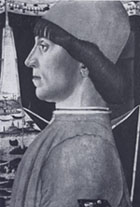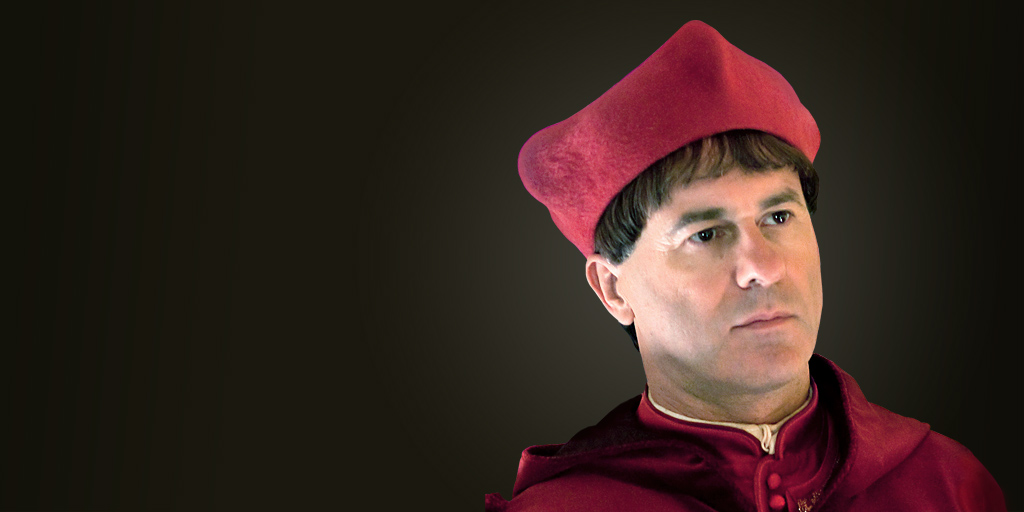Ascanio Sforza
Ascanio Maria Sforza (* March 3, 1455 in Milan, † May 28, 1505 in Rome ) from the family Sforza was the sixth son of the Duke Francesco I Sforza of Milan, Bianca Maria Visconti. His brothers were the dukes of Milan Galeazzo Maria Sforza and Ludovico Sforza, called ' il Moro ".
Life
Ascanio Maria Sforza was Archbishop of Eger and was elevated to cardinal with the title of diakonia Santi Vito, Modesto e Crescenzia in 1484 by Pope Sixtus IV. As a cardinal, he saw it as his task to develop and maintain the power of the Sforza. Before 1499 belonged to the Duchy of Milan, which had been usurped by his brother Ludovico Sforza, the most influential in Italy. Milan, however, was a fief of the Holy Roman Empire and was thus nominally the Emperor -. . Initially Frederick III, from 1493, his son Maximilian I. Ludovico's situation was especially so precarious, because he the rightful heir to the Milanese throne, Galeazzo Maria Sforza ( Moreover, with the Isabella of Aragon (1470 - 1524) was married a granddaughter of king Ferrante of Naples ) to displace from the rule sought. As long as the Emperor Frederick lived, he had also no way to be lawfully invested with the ducal crown - the Habsburgs refused the descendant of the Condottiere Muzio Attendolo simply as a parvenu from. Therefore, the Sforza were - like all the Italian Princes - under constant existential pressure and were forced to continually enter into shifting alliances.
The Sforza had initially supported the choice Rodrigo de Borgia pope, originally similar result can be on a lead in the hope that this will, as it was presented with his predecessor Innocent VIII Giuliano della Rovere. Ascanio wanted even after the death of Innocent are 1492 Pope in July, but with his 37 years, he was not only young, but also exposed by his family too political. Even in the conclave drew Ascanio all the stops with a power of attorney to his brother's vote-buying and the numerous benefices of the Vice Chancellor of the Curia, Rodrigo Borgia, for the trade of the papal throne was sold literally. As the secretary to Cardinal Barbo, Giovanni Lorenzi, had held before the conclave, the two established the world had divided among themselves: the Vice-Chancellor is Pope, but Ascanio About Pope.
But Alexander VI. ( the Pope name Rodrigo de Borgia ), who - like his uncle Calixtus III. - In Naples saw a possible Borgia rule, playing his own game. This Ludovico Sforza was forced France to ask for assistance; Charles VIII considered himself anyway as rightful heir of the kingdom of Naples, and had - after just against Maximilian I lost war of succession to Burgundy not only hands-free, but also sought after to finally cover with glory. The French king should also not only off Ferrante, but also force a council to depose the insubordinate in the eyes of the Sforza Pope - of course with the idea that Ascanio was finally able to access even after the tiara. (Alexander had negotiated in the meantime with the Neapolitans - Naples was, after all, a papal fief - and had a wedding conjunction with the Aragonese envisaged )
The following Italian campaign of Charles VIII was indeed victorious, but only what Naples were concerned - for the king renounced a council, and Alexander was able to pull his head in negotiations out of the loop.
The French troops in Italy were increasingly identified threat to the European balance of power - perceived and especially by the Italian city-states and territorial rulers as a threat. The Sforza were forced once again to change their allies under the pressure of Italian affairs. Together with Spain, the emperor, Venice, and the Pope, they formed a league against France and distributed on 6 July 1495 the Battle of Fornovo the French troops from Italy.
Ascanio was now come to the Curia in the crossfire, and threatened Giuliano della Rovere between ( who had gone first to the conclave into exile in France, where the king wanted to win a council against Alexander, but now at the request of the king with the Pope -) and the Borgia had reconciled to be consumed - temporarily. When Charles VIII died in 1497 - he had run in his castle in Amboise against a bar and had apparently suffered a stroke as a result of head injury - was Louis XII. from the house of Orléans French king. Was Karl was still an ally Ludovico, as the situation changed fundamentally since the Orléans were related to the Visconti - and precisely this had been driven by the Sforza of Milan. Thus, the new French ruler stretched out his hands to Milan.
In 1500, French troops had finally occupied the residence city of Milan Sforza family. Cardinal Ascanio Sforza assisted his brother - who had gone with his family in the meantime to Austria into exile ( Bianca Maria Sforza was married to the Roman-German king and later Emperor Maximilian I ) - in the battle for the recapture of the city. As Ludovico Sforza, however, his Swiss mercenaries could not pay, he was delivered to the French of these in April 1500. Ludovico should die in 1508 in French captivity. Cardinal Ascanio Sforza was - also 1500 - shipped from Venice to the French. Unlike his brother, he was not thrown into a dungeon, but only received house arrest and was released in 1502 on the condition not to leave France. Cardinal Ascanio Sforza has even reached the French court under Louis XII. launched and quickly became a permanent hunting companions of the French king. He caused a sensation when he let the French queen hand over an unusually large pearl, which bore his brother Ludovico earlier.
In August 1503 Louis XII allowed. the cardinal to return to Rome. Pope Alexander VI. had died, and Cardinal Ascanio Sforza assured the French king to give his voice to the French Cardinal Georges d' Amboise. The policy of the operation of the cardinal was, however, still focused on the rehabilitation of his family, the reinstatement of his incarcerated in a French prison brother Ludovico as Duca in Milan and the expulsion of the French from Lombardy. In keeping with its promise to the French king Cardinal Sforza actually chose the favored by the French court, Cardinal, however, made sure that in the conclave finally Francesco Nanni Todeschini - Piccolomini, Pope Pius III. was elected Pope. . Pius III, who was especially Giuliano della Rovere prevent proved, however, only as a stopgap - he already died four weeks after his election. This paved the way for Giuliano della Rovere was finally free, which reached as Julius II on the Chair of Peter.
However, when Pope Julius II also belonged to the Sforza's not a well-meaning Italian royal family, united them the goal to end France's influence in Italy. The policy Julius escalated in 1510, finally in an open struggle against the French troops located in northern Italy. Cardinal Ascanio Sforza did not live it. He died at the age of 50 on May 28, 1505.
The tomb
Ascanio Maria Sforza's tomb, which was by Julius II in spite of the opposition to Andrea Sansovino given (around 1467-1529 ) in order, is in the church of Santa Maria del Popolo in Rome " Cappella Maggiore ". It is the first triumphal arch triaxial grave, which was built in Rome, and bears the inscription:
This unusual gesture appearing Julius II has a real political background. For Julius II, the family of Sforza as the legitimate Duke of Milan important allies in the fight against the French troops. The tomb of Pope documented from the Rovere family that he recognized their rule over Milan.
Influence on the history of music
After Ascanio Sforza's entry into Rome, he called probably the composer Josquin Desprez (c. 1450/55-1521 ) in the papal chapel singers. The relationship between Ascanio Sforza and Desprez was so tight that some compositions of Josquin are handed down under the indication of the author " Josquin Dascanio ".










